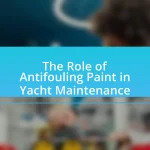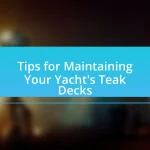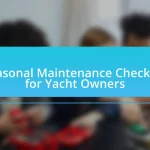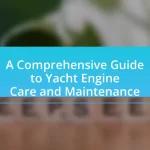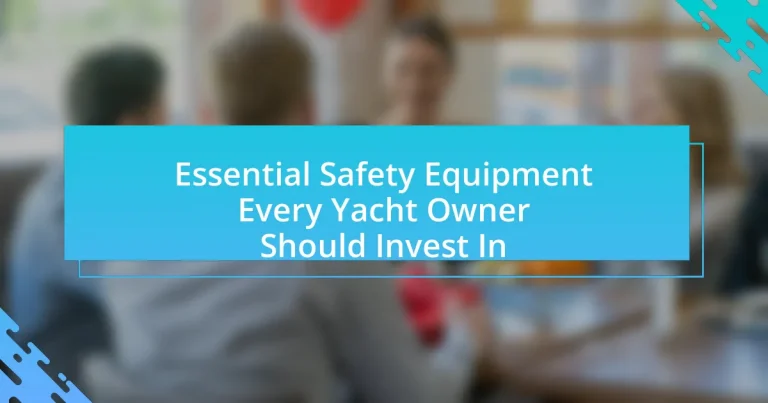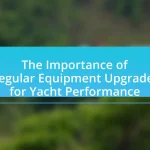Essential safety equipment for yacht owners includes life jackets, fire extinguishers, flares, first aid kits, and VHF radios, all of which are crucial for ensuring safety during maritime activities. The article emphasizes the importance of these items in preventing accidents, addressing emergencies, and complying with maritime regulations. It discusses the potential risks of lacking safety equipment, the legal requirements for yachts, and best practices for maintaining and using this gear effectively. Additionally, it highlights the significance of regular inspections, crew training, and the creation of safety checklists to enhance overall safety on board.
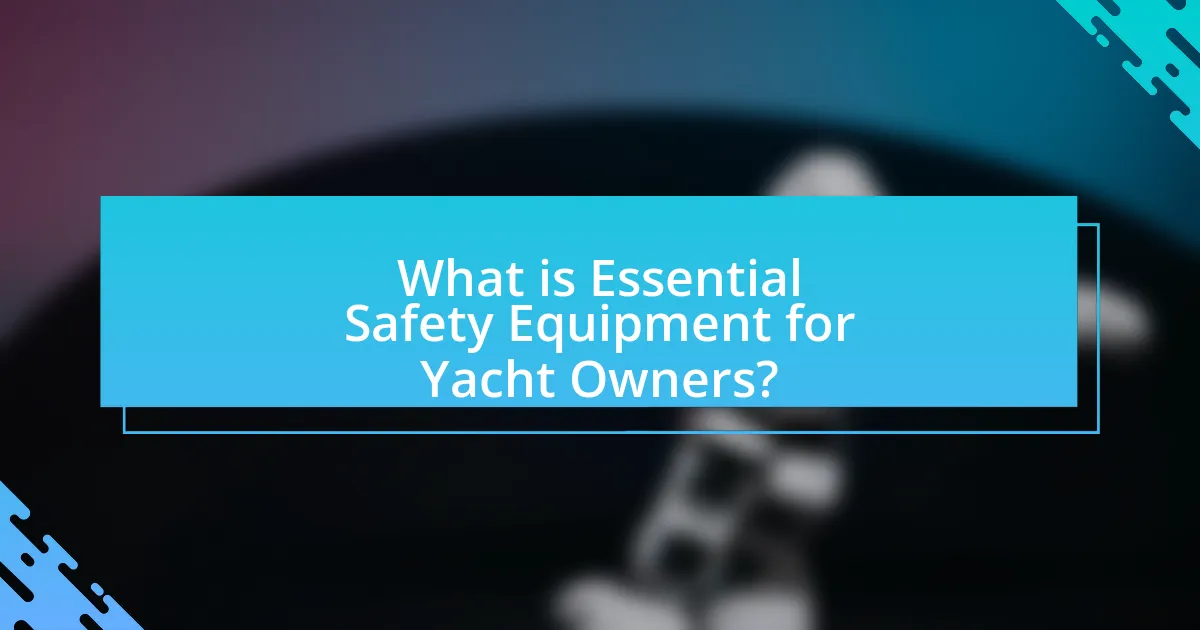
What is Essential Safety Equipment for Yacht Owners?
Essential safety equipment for yacht owners includes life jackets, fire extinguishers, flares, a first aid kit, and a VHF radio. Life jackets are crucial for ensuring the safety of all passengers in case of emergencies, as they provide buoyancy and prevent drowning. Fire extinguishers are necessary to combat onboard fires, which can occur due to electrical faults or cooking accidents. Flares serve as visual distress signals, alerting nearby vessels or rescue services in case of emergencies. A first aid kit is essential for addressing injuries or medical issues that may arise during a voyage. Lastly, a VHF radio is vital for communication with other vessels and emergency services, ensuring that yacht owners can call for help if needed. These items are not only recommended but often required by maritime safety regulations, underscoring their importance for safe boating practices.
Why is safety equipment crucial for yacht owners?
Safety equipment is crucial for yacht owners because it significantly reduces the risk of accidents and enhances the safety of all onboard. The unpredictable nature of marine environments, including sudden weather changes and potential emergencies, necessitates the presence of reliable safety gear. For instance, the U.S. Coast Guard reports that life jackets can prevent drowning, which is a leading cause of fatalities in boating incidents. Additionally, having fire extinguishers, flares, and first aid kits readily available can mitigate the consequences of emergencies, ensuring a swift response to incidents. Thus, investing in safety equipment is essential for protecting lives and ensuring compliance with maritime regulations.
What are the potential risks of not having safety equipment?
The potential risks of not having safety equipment include increased likelihood of accidents, injuries, and fatalities during maritime activities. Without essential safety gear such as life jackets, fire extinguishers, and first aid kits, individuals on a yacht face greater exposure to drowning, fire hazards, and untreated medical emergencies. Statistics indicate that drowning accounts for approximately 70% of boating fatalities, highlighting the critical role of life-saving equipment. Furthermore, the absence of safety equipment can lead to legal repercussions, as regulations mandate specific safety standards for vessels.
How does safety equipment enhance overall boating experience?
Safety equipment significantly enhances the overall boating experience by providing essential protection and peace of mind. When boaters utilize life jackets, fire extinguishers, and emergency signaling devices, they reduce the risk of accidents and injuries, ensuring a safer environment on the water. According to the U.S. Coast Guard, wearing a life jacket can increase survival rates in boating accidents by up to 80%. This statistic underscores the critical role that safety equipment plays in not only preventing incidents but also in fostering confidence among boaters, allowing them to enjoy their time on the water without undue worry.
What types of safety equipment should every yacht owner consider?
Every yacht owner should consider essential safety equipment such as life jackets, fire extinguishers, flares, a first aid kit, and a VHF radio. Life jackets are crucial for ensuring the safety of all passengers in case of emergencies, as they provide buoyancy and prevent drowning. Fire extinguishers are necessary for combating onboard fires, with regulations often requiring at least one extinguisher for every 50 feet of vessel length. Flares serve as visual distress signals, vital for attracting attention during emergencies. A well-stocked first aid kit is important for addressing injuries or medical issues that may arise while at sea. Lastly, a VHF radio is essential for communication with other vessels and emergency services, enhancing safety through reliable contact. These items are not only recommended but often mandated by maritime safety regulations, underscoring their importance for yacht safety.
What are the essential personal flotation devices?
The essential personal flotation devices (PFDs) include life jackets, buoyancy aids, and inflatable vests. Life jackets are designed to keep a person afloat and are required by law in many jurisdictions for all boaters. Buoyancy aids provide less flotation than life jackets and are suitable for activities like kayaking or sailing in calm waters. Inflatable vests offer comfort and are compact until deployed, making them popular among recreational boaters. According to the U.S. Coast Guard, wearing a PFD can significantly increase survival rates in water emergencies, highlighting their critical role in boating safety.
How do fire extinguishers contribute to yacht safety?
Fire extinguishers significantly enhance yacht safety by providing immediate means to combat onboard fires, which can escalate rapidly in confined spaces. Their presence allows crew and passengers to respond quickly to fire incidents, potentially preventing catastrophic damage or loss of life. According to the U.S. Coast Guard, fire is one of the leading causes of boating accidents, underscoring the necessity of having properly maintained fire extinguishers on board. Regular inspections and adherence to safety regulations ensure that these extinguishers are functional and accessible, further reinforcing their critical role in emergency preparedness on yachts.
What role do first aid kits play in emergency situations?
First aid kits play a critical role in emergency situations by providing essential medical supplies to address injuries and health issues promptly. These kits typically contain items such as bandages, antiseptics, and medications, which can be vital for treating wounds, preventing infections, and managing pain until professional medical help arrives. Research indicates that having a well-stocked first aid kit can significantly reduce the severity of injuries and improve outcomes in emergencies, as timely intervention is crucial in such scenarios.
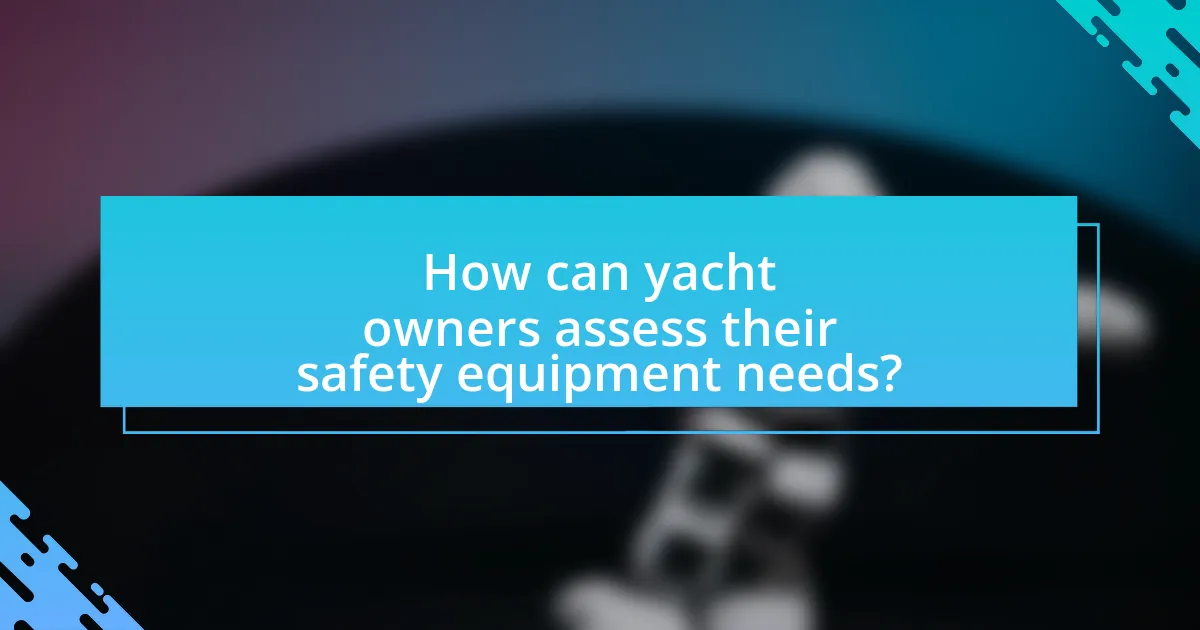
How can yacht owners assess their safety equipment needs?
Yacht owners can assess their safety equipment needs by conducting a thorough inventory of required safety gear based on regulations and specific sailing conditions. The International Maritime Organization (IMO) and local maritime authorities provide guidelines that outline mandatory safety equipment, such as life jackets, flares, and fire extinguishers, which vary depending on the size of the yacht and the waters navigated. Additionally, yacht owners should evaluate their sailing habits, including the number of passengers, the duration of trips, and the potential for adverse weather, to determine if additional equipment, like EPIRBs (Emergency Position Indicating Radio Beacons) or first aid kits, is necessary. Regular safety drills and equipment checks further ensure that all safety gear is functional and meets current safety standards.
What factors should be considered when selecting safety equipment?
When selecting safety equipment, key factors include compliance with safety regulations, suitability for specific activities, and the quality of materials used. Compliance ensures that the equipment meets legal standards, which is crucial for safety and liability. Suitability refers to the equipment’s effectiveness for the intended use, such as life jackets designed for boating versus those for other water activities. Quality of materials impacts durability and reliability; for instance, equipment made from high-grade materials is less likely to fail in emergencies. These considerations are essential for ensuring the safety of yacht owners and their passengers.
How does the size and type of yacht influence safety equipment choices?
The size and type of yacht significantly influence the choices of safety equipment due to varying requirements for stability, capacity, and operational conditions. Larger yachts typically necessitate more extensive safety gear, such as multiple life rafts, advanced fire suppression systems, and comprehensive medical kits, to accommodate a greater number of passengers and crew, as mandated by maritime safety regulations. For instance, yachts over 24 meters in length are required to have specific safety equipment, including EPIRBs (Emergency Position Indicating Radio Beacons) and lifeboats, as outlined by the International Maritime Organization (IMO) standards. Conversely, smaller yachts may require less equipment, focusing on essentials like personal flotation devices and basic first aid kits, reflecting their limited capacity and operational scope. Thus, the yacht’s size and type directly dictate the complexity and quantity of safety equipment needed to ensure compliance with safety regulations and the well-being of all onboard.
What are the legal requirements for safety equipment on yachts?
The legal requirements for safety equipment on yachts vary by country and jurisdiction, but generally include items such as life jackets, fire extinguishers, flares, and a first aid kit. For example, in the United States, the Coast Guard mandates that vessels must have a personal flotation device for each person on board, a sound-producing device, and visual distress signals. Additionally, many regions require fire extinguishers based on the size of the yacht and the presence of an enclosed space. Compliance with these regulations is crucial for ensuring safety and avoiding penalties.
How often should safety equipment be inspected and maintained?
Safety equipment should be inspected and maintained at least annually. Regular inspections ensure that equipment functions correctly and meets safety standards, as outlined by organizations such as the U.S. Coast Guard, which recommends annual checks for life jackets, fire extinguishers, and other critical safety gear. Additionally, equipment should be inspected after any significant use or exposure to harsh conditions, as wear and tear can compromise safety.
What are the best practices for maintaining personal flotation devices?
The best practices for maintaining personal flotation devices (PFDs) include regular inspections, proper cleaning, and appropriate storage. Regular inspections should occur before each use, checking for signs of wear, damage, or deterioration, as PFDs can lose buoyancy and effectiveness over time. Cleaning PFDs with mild soap and water after exposure to saltwater or chlorine helps prevent material degradation. Proper storage in a cool, dry place away from direct sunlight protects the PFDs from UV damage, which can weaken the fabric and stitching. Following these practices ensures that PFDs remain functional and safe for use, as recommended by safety organizations like the U.S. Coast Guard.
How can yacht owners ensure their fire extinguishers are functional?
Yacht owners can ensure their fire extinguishers are functional by conducting regular inspections and maintenance. This includes checking the pressure gauge to confirm it is in the green zone, ensuring the extinguisher is free from physical damage, and verifying that the inspection tag is up to date. According to the National Fire Protection Association (NFPA), fire extinguishers should be inspected monthly and undergo professional servicing annually to maintain compliance and effectiveness.
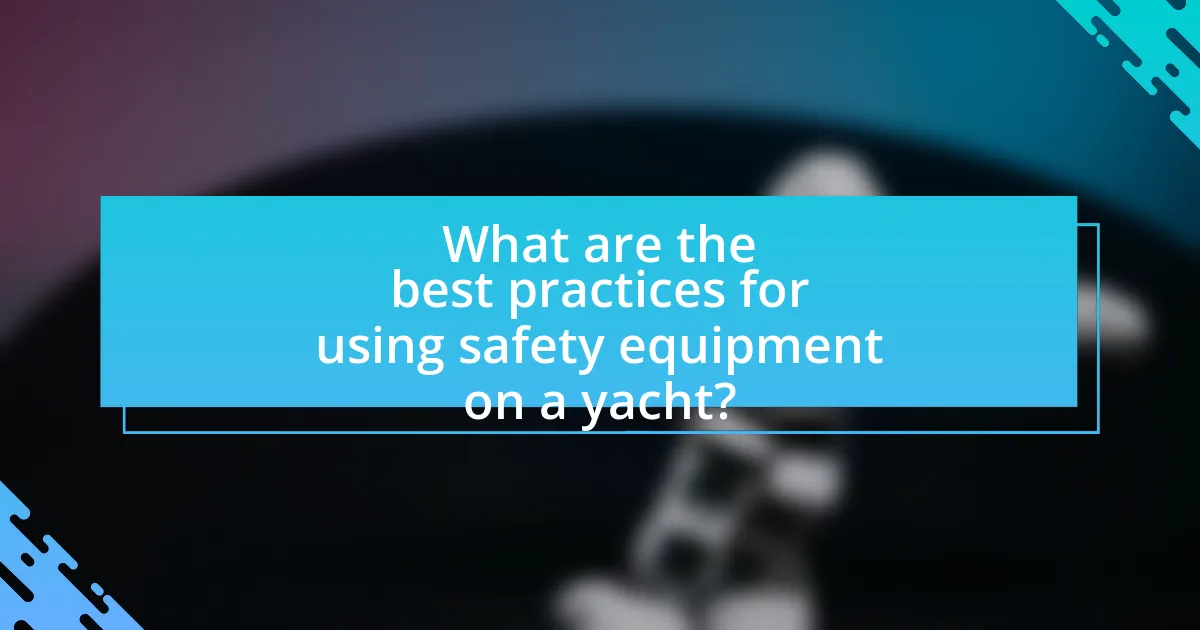
What are the best practices for using safety equipment on a yacht?
The best practices for using safety equipment on a yacht include regular inspection, proper training, and immediate accessibility. Regular inspection ensures that all safety gear, such as life jackets, fire extinguishers, and flares, are in good working condition and compliant with maritime regulations. Proper training involves educating all crew members on how to use safety equipment effectively, which can significantly reduce response times in emergencies. Immediate accessibility means that safety equipment should be stored in easily reachable locations, allowing for quick access during critical situations. These practices are essential for enhancing safety and preparedness on board, as evidenced by maritime safety studies indicating that well-maintained and readily accessible safety equipment can reduce accident-related fatalities by up to 50%.
How should yacht owners educate their crew about safety equipment?
Yacht owners should educate their crew about safety equipment through comprehensive training sessions that include hands-on demonstrations and regular drills. This approach ensures that crew members are familiar with the equipment’s location, operation, and maintenance. According to the International Maritime Organization, effective training can significantly reduce accidents and enhance safety awareness among crew members. Regularly scheduled safety briefings and updates on equipment changes also reinforce knowledge and preparedness, aligning with best practices in maritime safety.
What training is recommended for effective use of safety equipment?
Training recommended for effective use of safety equipment includes hands-on instruction in the proper operation of each device, regular drills to practice emergency procedures, and comprehensive education on safety protocols. This training ensures that yacht owners and crew are familiar with equipment such as life jackets, fire extinguishers, and emergency beacons, which is crucial for effective response in emergencies. According to the U.S. Coast Guard, regular safety drills and training can significantly reduce the risk of accidents and improve overall safety on board.
How can regular drills improve safety preparedness on a yacht?
Regular drills significantly enhance safety preparedness on a yacht by ensuring that crew members are familiar with emergency procedures and equipment. These drills provide practical experience, allowing crew to practice responses to various scenarios such as man overboard, fire, or flooding. According to the U.S. Coast Guard, regular safety drills can reduce response times in emergencies by up to 50%, demonstrating their effectiveness in improving readiness. Furthermore, consistent practice helps identify gaps in knowledge or equipment, allowing for timely corrections and ensuring that all safety protocols are understood and can be executed efficiently during an actual emergency.
What common mistakes do yacht owners make regarding safety equipment?
Yacht owners commonly make mistakes such as neglecting regular inspections of safety equipment, failing to ensure that all equipment is up to date and compliant with regulations, and underestimating the importance of having adequate personal flotation devices for all passengers. Regular inspections are crucial because equipment can deteriorate over time; for instance, the U.S. Coast Guard reports that many boating accidents occur due to equipment failure, highlighting the need for proper maintenance. Additionally, yacht owners often overlook the necessity of having a comprehensive safety plan that includes emergency procedures, which can lead to confusion during critical situations.
How can yacht owners avoid neglecting safety equipment checks?
Yacht owners can avoid neglecting safety equipment checks by implementing a regular maintenance schedule that includes specific dates for inspections. This proactive approach ensures that safety equipment, such as life jackets, fire extinguishers, and flares, is routinely checked for functionality and compliance with safety regulations. According to the U.S. Coast Guard, regular inspections can significantly reduce the risk of accidents at sea, as equipment failures are a common cause of maritime incidents. By setting reminders and utilizing checklists, yacht owners can systematically verify that all safety gear is in optimal condition, thereby enhancing overall safety on board.
What are the consequences of using outdated safety equipment?
Using outdated safety equipment can lead to severe consequences, including increased risk of accidents and injuries. When safety gear is not up to date, it may fail to meet current safety standards, resulting in inadequate protection during emergencies. For instance, outdated life jackets may not provide sufficient buoyancy or may have deteriorated materials that compromise their effectiveness. According to the U.S. Coast Guard, improper or outdated safety equipment is a leading cause of fatalities in boating accidents, highlighting the critical need for regular equipment updates to ensure safety on the water.
What tips can enhance safety equipment effectiveness on a yacht?
Regular maintenance of safety equipment enhances its effectiveness on a yacht. Ensuring that life jackets, fire extinguishers, and emergency beacons are in good working condition is crucial, as equipment that is not properly maintained can fail during emergencies. Additionally, conducting regular drills with the crew to familiarize them with the location and operation of safety equipment increases readiness and response time in critical situations. According to the U.S. Coast Guard, proper training and maintenance can significantly reduce the risk of accidents at sea, highlighting the importance of these practices for yacht safety.
How can yacht owners create a safety equipment checklist?
Yacht owners can create a safety equipment checklist by identifying essential safety items required for safe boating and ensuring compliance with maritime regulations. This process involves researching local laws and guidelines, such as those provided by the U.S. Coast Guard, which mandates specific safety gear like life jackets, fire extinguishers, and signaling devices. Additionally, yacht owners should consider including items such as first aid kits, flares, and emergency beacons to enhance safety. Regularly reviewing and updating the checklist based on the yacht’s usage and any changes in regulations ensures that all necessary equipment is accounted for and in good condition.
What resources are available for staying updated on safety equipment standards?
To stay updated on safety equipment standards, yacht owners can utilize resources such as the American National Standards Institute (ANSI), the International Organization for Standardization (ISO), and the U.S. Coast Guard’s website. These organizations provide comprehensive guidelines and updates on safety standards relevant to marine equipment. For instance, ANSI publishes standards that are widely recognized in the industry, while ISO offers international standards that ensure safety and quality. The U.S. Coast Guard regularly updates regulations and safety requirements for boating equipment, making their website a crucial resource for compliance and safety information.

